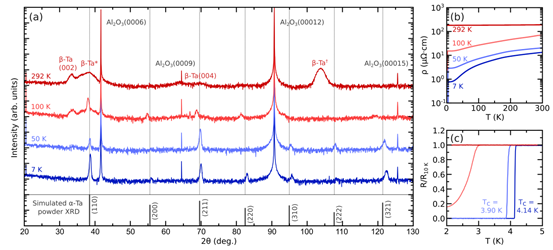Cryogenic growth of tantalum thin films for low-loss superconducting circuits
2024-05-23 16:33
1341 浏览
Motivated by recent advancements highlighting Ta as a promising material in low-loss superconducting circuits and showing long coherence times in superconducting qubits, we have explored the effect of cryogenic temperatures on the growth of Ta and its integration in superconducting circuits. Cryogenic growth of Ta using a low temperature molecular beam epitaxy (MBE) system is found to stabilize single phase α-Ta on several different substrates, which include Al2O3(0001), Si(001), Si(111), SiNx, and GaAs(001). The substrates are actively cooled down to cryogenic temperatures and remain < 20 K during the Ta deposition. X-ray θ-2θ diffraction after warming to room temperature indicates the formation of polycrystalline α-Ta. The 50 nm α-Ta films grown on Al2O3(0001) at a substrate manipulator temperature of 7 K have a room temperature resistivity (ρ300 K) of 13.4 µΩ·cm, a residual resistivity ratio (RRR) of 17.3 and a superconducting transition temperature (TC) of 4.14 K, which are comparable to bulk values. In addition, atomic force microscopy (AFM) indicates that the film grown at 7 K with an RMS roughness of 0.45 nm was significantly smoother than the one grown at room temperature. Similar properties are found for films grown on other substrates. Results for films grown at higher substrate manipulator temperatures show higher ρ300 K, lower RRR and Tc, and increased β-Ta content. Coplanar waveguide resonators with a gap width of 3 µm fabricated from cryogenically grown Ta on Si(111) and Al2O3(0001) show low power Qi of 1.9 million and 0.7 million, respectively, indicating polycrystalline α-Ta films may be promising for superconducting qubit applications even though they are not fully epitaxial.


Structural and electrical characterization of tantalum as growth temperature
Ta films have been grown on c-plane sapphire at different cryogenic temperatures and room temperature. Our findings indicate that the electrical properties are optimal when Ta is grown at the lowest temperature possible. The structure of the films is identified as single phase α-Ta exhibiting a polycrystalline structure. An important advantage of this approach is the lack of epitaxy at low temperatures, allowing the α-Ta phase to be grown on either amorphous or crystalline substrates with comparable electrical properties. The microwave characterization of Ta on Si(111) and Ta on Al2O3(0001) shows high-performing resonators. Specifically, Si(111) demonstrated significantly better performance with a Qi,LP =1.9 million compared to Al2O3(0001) with a with a Qi,LP= 0.7 million. This shows that low-loss superconducting circuits made from single phase polycrystalline α-Ta are promising despite the lack of epitaxy.
文章来源:arXiv:2405.12417
